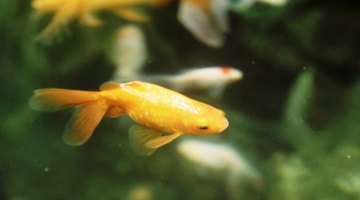How to Clear Green Water in a Fish Pond
Green water appears in fish ponds with startling speed -- sometimes water can turn green overnight. Most bodies of water contain small, free-floating particles of microscopic algae, but chemical imbalances in the water can cause the particles to multiply rapidly.

Things You Will Need
- Algaecide
- Pool rake
- Filtration system
- Water test kit
Tip
Continue weekly cleaning and maintenance to prevent the algae's return. Correcting the conditions that create free-floating green algae can take several weeks or months.
Excessive amounts of decomposing organic materials in the water eventually lead to the creation of large amounts of nitrates, which the algae thrive upon. Fertilizer running into the pond acts like a steroid to the free-forming algae. Algaecides help to clean green water in a fish pond immediately, but the removal and control of algae-spawning materials both fixes the problem and prevents its return.
-
Treat the fish pond with an algaecide to clear the water quickly. Check the labeling to make sure the algaecide kills free-floating green algae and is compatible with the fish and plants in the fish pond. Follow the directions on the algaecide's label when applying it to the pond.
-
Clean out the excessive organic matter in the pond. Remove any leaves in the water. Dredge the bottom of the pond with a pool rake, collecting and removing as much sludge as possible.
-
Install a water filtration system. Follow the installation instructions that come with the machine. Clean the filters in the system once per week, or even more regularly if the system demands it.
-
Change the physical conditions leading to the algae buildup. Remove some of the plants or fish in the pond, or do not replace them as they die, to reduce the amount of algae-spawning organic matter in the pool. Place netting over the pond to prevent leaves from overhanging trees from falling into the water. Apply fertilizer surrounding lawn and plants carefully to minimize the chance of nitrogen seeping into the pond.
-
Maintain the water's pH level to keep it between 6.5 and 7.5. Test the pond's pH level once the water begins to clear a bit. Add 1 tsp. of pure baking soda per 500 gallons of water to raise the pond's pH level, or add 1/4 cup of undiluted white vinegar per 500 gallons to lower the pH level. Test the water again after 12 hours, then add another portion if needed.
References
Writer Bio
Brad Chacos started writing professionally in 2005, specializing in electronics and technology. His work has appeared in Salon.com, Gizmodo, "PC Gamer," "Maximum PC," CIO.com, DigitalTrends.com, "Wired," FoxNews.com, NBCNews.com and more. Chacos is a frequent contributor to "PCWorld," "Laptop Magazine" and the Intuit Small Business Blog.
Photo Credits
- Jupiterimages/Photos.com/Getty Images
- Jupiterimages/Photos.com/Getty Images
More Articles



